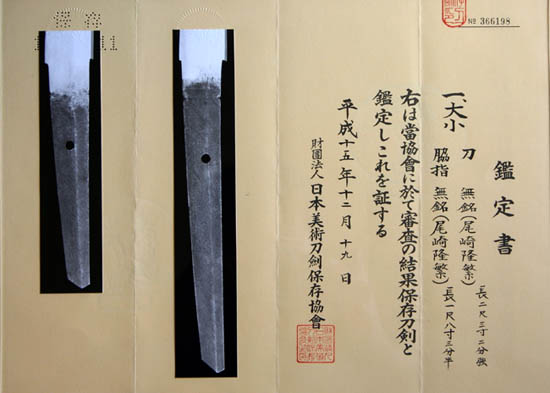Archived Nihonto.ca (Yuhindo.com): Ozaki Takashige
Ozaki Takashige
| designation: | NBTHK Hozon Daisho Token |
| period: | Shinshinto |
| nakago: | Ubu mumei, 1 mekugiana (on each) |
| dai nagasa: | 70.29cm |
| sho nagasa: | 55.5cm |
| price: | N/A |
Ozaki Takashige is a swordsmith working around 1820 in Osaka. His father and teacher is a famous smith, Suketaka, who worked around 1753. Suketaka was involved in the revival of the Toranba style of Sukehiro, and attracted many students. Takashige faithfully reproduced the style that his father worked in.
Takashige had a son, Masataka, who also gained some fame as a leading smith of the Shinshinto period.
Swords
The daisho presented here today is faithful to the typical style that Takashige worked in. At a glance, they can be seen to have the features of the typical Osaka Toranba that Sukehiro fathered. They are a well sized pair, as the wakizashi is nearing katana length and the katana is over 70cm in nagasa. The hamon is Toranba in Sukehiro style, with nie and a nice style overall in the hamon. The wakizashi is superior to the katana in workmanship, and this may be because the Osaka smiths made many wakizashi and so obtained particular skill in their manufacture. The kitae is a mix of very tight ko-itame, with some running masame… in the katana there is some loose grain along the masame lines. It is shown in the pictures.
The swords are in old sashikomi polish (possibly the original 200 year old polish), and as a result they are more subtle and a bit difficult for me to photograph. I have not photographed anything that didn’t have a keisho polish before, so my formal sugata pictures did not come out properly. They lack the contrast usually provided by the polish. If you want to look, click here, but they do not properly describe the swords… please check the slideshow for a better description, as the informal pictures worked better with this polish.
Koshirae
The koshirae are black lacquered, with shibuichi fittings featuring silver and gold cranes in a marsh theme and leopard and tiger menuki. The tsuba are iron with gold leaf pine trees. The ito is original. Both habaki are solid silver.
Daisho Token
There is some discussion that goes on about what exactly makes a daisho. There are several definitions.
To begin the discussion, most times samurai did not get their swords as a pair, unless they were well off and could order a matched pair from a swordsmith. Often times, their lord would present them one sword and they would be expected to get another on their own… if they were lucky they would be provided the long katana and their purchase would be a wakizashi.
Sometimes they would just forego the paired swords if another could not be had, and other times a tsunagi would take the place of one of the two blades.
In general then, a daisho is considered by the koshirae as the swords may be naturally from different makers. Provided that the koshirae are antique and made for the two swords, that the swords belong to the koshirae is the important thing.
In some rare cases, swords can be found that were made to exist together by the same hand. In this case, if they are clearly intended as a pair, they may be considered daisho token. This is quite rare and unusual to find. Most times when you look at a “daisho” offered for sale, you will find two separate papers. This often means that the vendor found two swords by the same smith, one a wakizashi and one a katana, and united them and are now selling them as a pair.
This is simply two swords. Even if koshirae are made for them now, they are not a daisho because no samurai wore these swords as a pair, and they have nothing to do with each other outside of the fact that they are made by the same smith. They do enhance each other’s value somewhat, but they lack the rarity and collectability that a true daisho has. It is usually considered that a “true” daisho will increase the value of the pair 100% over their value as individual swords.
This pair of swords today is a daisho by any definition. They reside in their original antique koshirae, made for this pair of swords, and they were made by the same hand, intended as a pair for a samurai almost two hundred years ago. The NBTHK has certified this by issuing Daisho Token papers when I submitted them to Hozon shinsa in 2003. Both swords are thus recorded on a single paper. It is a very important distinction, because it is one of authenticity and originality. Daisho are rare and wonderful items to have, especially when the swords are by the same maker and the koshirae are present.
The katana is unsigned, as is the wakizashi. This is something that one encounters every now and then in the Shinshinto period. It is theorized that with growing unrest towards the end of the Edo period that some smiths did not sign their work if it was going to the “other side” from where they stood. That is, should the owner be captured or killed, the work could not easily be traced back to them and so by not signing they could avoid potential punishment.
I do not know how much weight this theory holds, I do know that mumei Shinshinto pieces are not uncommon and so there must be some reason behind it.

